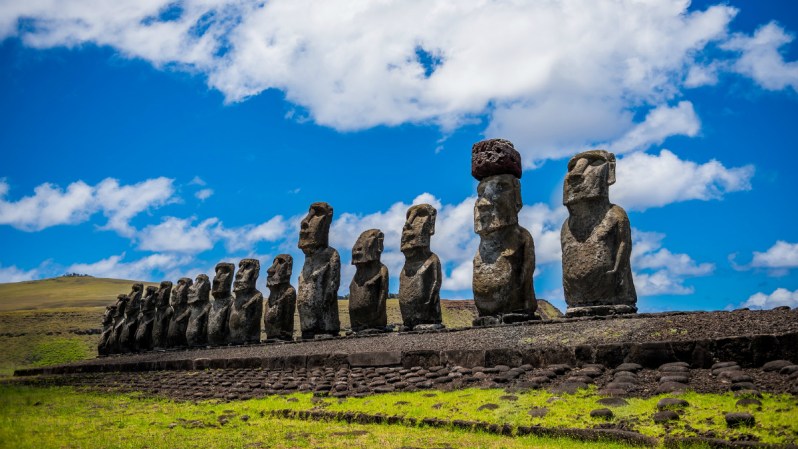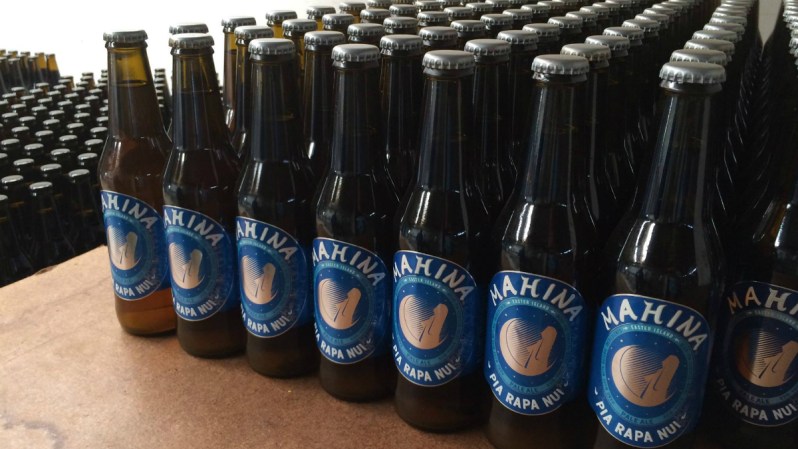There are few destinations left untouched by the craft beer boom. There’s a brewery in “end of the world” Patagonia. The remote African island of Mauritius has a solid beer bar. Even Antarctica’s Tatty Flag offers occasional craft options. But, one island brewery in the middle of the South Pacific Ocean claims to be the world’s most remote.
Assuming you don’t happen to be vacationing on Easter Island — and, frankly, what Americans do? — just getting to Cervecería Mahina requires some doing. First, you’ll need to get to the Chilean capital of Santiago. Then, you’ll need to board a flight that flies nearly six hours west over nothing but deep, open ocean. It’s roughly equidistant (2,400 miles) from Tahiti and the South American mainland. The journey there is nearly the equivalent of flying coast-to-coast across the United States. At some point over the Pacific Ocean, when it seems you’ve reached the literal middle of nowhere, tiny, 63-square-mile Easter Island emerges on the horizon.

Westerners who’ve heard of Easter Island — more accurately Rapa Nui — often know only of its legendary moai — the iconic, multi-ton stone figures whose origins remain shrouded in folklore. In fact, much of the island’s history is a mystery. Best we can surmise, it reads like the timeline of many exotic isles during the peak of European colonialism. Polynesians probably arrived at some point in the last thousand years, although no one knows when for sure. Fast-forward through centuries of conquering and reconquering and re-reconquering by the Dutch, then the Spanish, then the English. By the mid-19th-century, plague, civil war, and slavery had decimated the island’s population to but a few hundred native people.
Chile eventually took control of Easter Island around 1890 and severely restricted the rights of the indigenous Rapa Nui people. It wasn’t until the mid-1960s that they were allowed to do much of anything, including brew their own beer. Mahina’s owner, Mike Rapu, still recalls his grandfather being brutally whipped and beaten for bootlegging wine and corn-based liquor. The island’s history in general and that memory, in particular, were a big inspiration for Rapu to launch the brewery in the first place.

In 2008, Rapu met Pedro Salfate in Santiago. As a trained biologist, Salfate had experimented with homebrewing, so he already had the skills and the passion to make good beer. Two months after the meeting, he moved with his wife to Easter Island to be Mahina’s brewmaster. The brewery opened with just two beers, including a sweet, chocolatey Porter (6.8% ABV) and a British-style Pale Ale (4.8% ABV). Partly due to the novelty of its remote location, it rode a wave of success on the mainland. But the financial realities of exporting beer from a remote island more than 2,000 miles to the South America proper proved too much. It subsequently closed for a few years but reopened in 2013. Thanks to Easter Island’s steady tourism industry (and selling to hotels and restaurants), Mahina has been chugging along ever since. Today, they produce up to 3,000 liters of beer monthly.
The distribution of Mahina is limited to just Easter Island. Salfate says kegs and even an IPA may be available for sale one day. But, for now, he’s focused on his original Pale Ale and Porter — all hand-bottled, hand-labeled, and sold in local retail shops for $4-5 per six-pack. Bottom line: if you want “the secret taste of Easter Island” (the brand’s charming slogan), you’re going to have to go get it.



